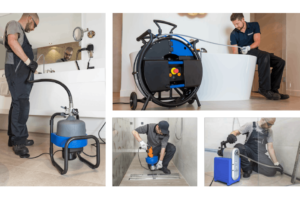Whether you want to brighten a space with natural morning sun or darken it for a movie-watching retreat, blinds offer superb light control. They can also protect carpets, furniture and household surfaces from fading caused by UV rays.

Blinds are available in a wide range of styles and colours to complement any decor. Choosing the right blinds requires careful consideration of function, cost and style. Visit https://www.customblindsandshadesky.com/ to learn more.
Blinds are available in a wide range of styles, colours and materials to suit any home decor. Some window treatments are also highly effective in controlling light and temperature – offering an affordable way to achieve energy efficiency.
Choose blinds with a thicker material for greater insulation. For example, cellular or honeycomb blinds feature insulating pockets that help regulate temperature and reduce energy consumption. This makes them an excellent choice for hot climates or sun-facing rooms. Blackout blinds are another option for extremely sunny rooms, blocking sunlight and helping lower cooling costs.
Aim for an ideal balance between light and shade to create a comfortable living environment without overheating the space. Tilt the slats of your blinds to redirect sunlight as it moves throughout the day or use a layered approach that includes a combination of blinds and drapes for maximum control.
Regularly inspect your blinds for gaps or loose fittings that can compromise their functionality and thermal efficiency. Also, be sure to clean them regularly with warm water and a mild detergent. This maintains the integrity of your blinds and helps prevent dust and grime buildup.
Sync your blinds with smart thermostats for optimised temperature management that combines comfort and savings. This integrated approach ensures your blinds always match your heating and cooling preferences, making it easier to achieve an eco-friendly lifestyle.
Blinds that automatically adjust based on the time of day are an innovative solution for managing indoor temperatures, especially for those who live with temperature sensitivity. They can be programmed to close during peak sunlight hours, reducing excessive heat gain and easing the strain on air conditioning systems. Alternatively, they can be opened during winter to allow in the sun’s warming rays and naturally warm the room.
Controlling Temperature
When closed with the slats facing up, blinds can help to maintain a cooler temperature in your home. This is especially beneficial in warmer months, as it helps to reduce energy costs by lowering your dependence on air conditioning and other cooling appliances. It also safeguards furniture, artwork and flooring from sun damage.
The slat size and material used to make your blinds are important factors to consider, as they can impact the amount of sunlight and heat that they allow in. Blinds with larger slats offer more protection against the sun’s damaging UV rays, while those with smaller slats can let in more natural light and create a brighter atmosphere.
Another factor to consider is the insulation value of your window blinds. Blinds made with advanced materials such as cellular shades, honeycomb blinds and solar film are highly effective at reducing heat gain in the summer and insulating against cold air loss in the winter. Blinds with a high R-value are often more cost-effective than other window treatments, such as curtains and drapes, which typically have lower R-values.
Besides improving their insulating capability, many modern blinds are also designed to be eco-friendly and aesthetically appealing. They can be crafted from wood, recycled plastics or bamboo, rattan and organic cotton, with some offering additional benefits like cordless operation or motorization for convenience and enhanced functionality.
The appearance of your window blinds can be further enhanced by adding accent features like valances, cornices, side panels and other decorative accessories. Alternatively, you can add your own custom finishing touches by painting the slats or having them customized. The variety of styles, colours and sizes available means you can find a set that perfectly complements your interior design.
Enhancing Appearance
Blinds come in a wide variety of styles and colours, making them a versatile window dressing option. You can choose to match or contrast your blinds with the decor in your space, and they can be paired with either curtains or drapes for a cohesive look. Blinds also offer a more modern aesthetic than shades and are easy to maintain. You can simply wipe them down with a damp cloth or vacuum them to keep them looking great.
The colour options for your blinds will allow you to maximize the light entering your room, creating a more open and airy feel. Opt for translucent or sheer blinds to diffuse natural light and visually expand your space, or try a patterned design for an eye-catching focal point in the room. You can even find blinds with geometric patterns if you’re not ready to commit to a full-on trend.
If you’re in the market for a more energy-efficient option, cellular or honeycomb shades are designed with insulating pockets that help regulate the temperature in your home and lower your energy bills. These are a great choice for rooms like the bedroom or kitchen where you’ll be cooking or doing dishes that may cause condensation.
Blinds are a flexible and cost-effective window treatment that can elevate the aesthetics of any space. Their customizable style and functionality make them a must-have for homeowners. With so many options available, there’s sure to be a blind that fits your decor style and meets your functional needs. With the right custom blinds, you’ll enjoy the benefits of privacy, light control and style for years to come. For more information on enhancing the appearance of your home with custom blinds, contact Mayfair Drapery & Rug Co.
Enhancing Privacy
Blinds are a great way to enhance privacy by providing a powerful visual deterrent, preventing neighbours and passersby from peering into your space. Combine privacy blinds with other security-boosting solutions, like exterior lighting and CCTV, to ensure you’re always protected from unwanted intrusions.
Blind styles offer varying degrees of light control and privacy. For example, top-down/bottom-up blinds allow you to control the slats separately, so you can open the upper slats for sunlight and a view while keeping the bottom slats closed for privacy. This is a great option for ground-floor rooms and spaces that face streets or other busy areas. Similarly, motorized blinds provide added convenience with remote operation. You can even program them to open and close at specific times of day, enhancing privacy for a relaxing movie night or sleeping environment.
Another factor to consider is fabric type and color. Some materials are more durable than others, so look for options that can withstand frequent use and cleaning without fading or warping. Additionally, opt for a style that features a cassette that encases the rolled-up blind to minimise gaps where light and prying eyes can penetrate.
A professional installer can help you select the right window treatments based on your unique security needs and home layout. They can also ensure your blinds are properly installed, ensuring safety and effective functionality. They can also recommend a variety of security upgrades that complement your existing blinds, including cordless blinds for children and pets to avoid strangulation hazards. In addition, they can advise you on a variety of energy-efficient blinds that can contribute to energy efficiency and sustainability by regulating indoor temperatures, reducing power consumption, and minimizing heat loss during colder months.
Enhancing Safety
Blinds can help enhance the safety of your home. Traditional window treatments often feature cords, which can pose hazards for young children and pets. Children can easily become entangled in the cords while playing with the window coverings or climbing on furniture near the windows. Fortunately, motorized blinds eliminate the need for cords and chains, eliminating entanglement risks while offering a sleek, modern look. Likewise, they can be integrated with smart home systems, allowing them to adjust automatically based on predetermined schedules or sensor inputs.
In addition, a simple command from your smartphone or voice assistant can open or close your blinds. This can be a huge benefit for homeowners who struggle to operate manual blinds or need to access hard-to-reach windows. This type of convenience can also help individuals with mobility challenges feel more secure in their homes by minimizing the risk of falls or other accidents.
Another security benefit of blinds is that they help conceal the contents of your home from unwanted visitors. This can be especially useful for homeowners who have expensive electronics, jewelry, or other prized possessions in their home. By obscuring visibility into a home, it becomes harder for burglars to survey the interior and can deter them from attempting break-ins.
As more people are concerned about privacy and security in their homes, blinds have been a great solution for homeowners who want to bolster the safety of their home. The versatility of blinds makes them a convenient, stylish, and effective option for any home. They can be used to control light, temperature, and privacy while enhancing the appearance of any room. If you’re interested in upgrading your home with a new set of window treatments, contact Love is Blinds today to learn more about the benefits of blinds and how they can enhance your home.


